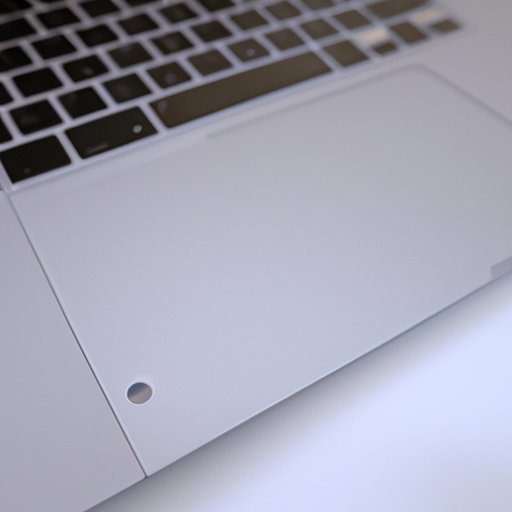I. Introduction
If you’re experiencing issues with your MacBook, resetting it may be a solution. Resetting a MacBook means erasing all data and settings, restoring it to its original factory state. There are many reasons why someone might need to reset their MacBook, including poor performance, software bugs, and security issues.
In this article, we will break down the process of resetting a MacBook into simple steps that you can follow along with. We will also provide screenshots, video tutorials, common problems and fixes, quick tips, as well as a comparison between resetting and restoring your MacBook.
II. Step-by-Step Guide
Resetting a MacBook can take time and preparation, so it’s important to know what you’re doing. Here is an overview of the main steps:
1. Backup your MacBook: Before resetting your MacBook, make sure to backup all of your important files and documents.
2. Sign out of iCloud: Sign out of iCloud and any other accounts that you’re signed into.
3. Enter into Recovery Mode: Shut down your MacBook and then start it up while holding Command + R keys.
4. Erase the hard drive: Select Disk Utility and then select the hard drive of your MacBook. Click erase and confirm a new name and format is set for the hard drive.
5. Reinstall macOS: Select Install macOS and confirm to reinstall the macOS for a clean setup.
Let’s go through each step in detail.
1. Backup your MacBook
Before resetting your MacBook, make sure you’ve saved all of your important files and documents in an external hard drive or cloud storage. You can use Apple’s Time Machine to backup your data.
2. Sign out of iCloud
It’s important to sign out of iCloud to avoid losing any information such as your contacts, emails, and bookmarks. You can easily sign out by going to the Apple menu, selecting System Preferences, then clicking on iCloud and finally, clicking Signout.
3. Enter into Recovery Mode
To reset your MacBook, you will need to enter into Recovery Mode. To enter recovery mode, shut down your MacBook and then start it up again while pressing and holding Command + R keys until showing the Apple logo.
4. Erase the hard drive
Once in Recovery Mode, select Disk Utility and choose the hard drive that you want to erase. It’s important to note that by doing this, you will delete everything including the macOS, all of your files, and any applications currently installed on your MacBook.
In Disk Utility, click Erase and confirm any noticeable changes such as a new name and format for the hard drive. Once the process is completed, click Done and exit Disk Utility to proceed with the next step.
5. Reinstall macOS
After erasing the hard drive, you are now ready to install the macOS. Select Install macOS and follow the instructions displayed on the screen.
III. Video Tutorial
If you prefer visual tutorials, we have also provided a video tutorial on how to reset your MacBook. The tutorial runs down the most critical steps with animations so that you don’t miss any detail. It’s also a good idea to follow along with the video while resetting your MacBook.
Link: https://www.youtube.com/watch?v=1vCZttrbn-0
IV. Common Problems and Fixes
Resetting your MacBook may come with a few problems. Here are some common problems and their fixes:
Problem: MacBook is stuck while erasing the hard drive.
Fix: Force restart your MacBook and repeat the process.
Problem: Can’t exit Recovery Mode.
Fix: Restart your MacBook and press and hold the Option key.
Problem: Can’t find the hard drive.
Fix: Check that your Mac is using the correct startup disk.
Problem: MacBook is too slow.
Fix: Close any open applications that are not needed. Also, make sure your MacBook is updated to the latest version of macOS.
V. Quick Tips
If you are already familiar with resetting your MacBook, here are some quick tips:
– Try resetting your MacBook from scratch, rather than through an existing backup.
– Be sure to use a stable internet connection for a faster software reinstallation.
– Make sure your MacBook is plugged in, fully charged, or connected to a power source before resetting.
VI. Differences between Reset and Restore
Resetting your MacBook is different from restoring your MacBook. While resetting erases all data and settings, restoring allows you to go back to a previous snapshot or copy of your MacBook’s installation.
If you are experiencing performance or software issues, it’s recommended to reset your MacBook. However, if you simply want to revert to an earlier installation, restoring is a better option.
VII. Conclusion
Resetting your MacBook can solve a lot of problems, and we hope this article has provided the guidance you need to do it successfully. Remember to back up your data, sign out of iCloud, boot into Recovery Mode, erase your hard drive, and finally reinstall macOS.
If you encounter any issues, follow our troubleshooting tips, apply the quick tips, and watch the video tutorial to help you. Remember to keep your MacBook updated and clear unnecessary applications and files for better performance.
Thank you for reading, and if you need additional support, don’t hesitate to reach out to Apple Support.
